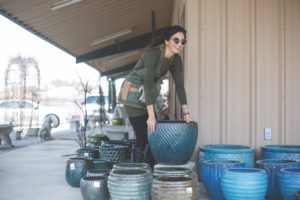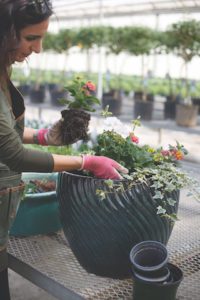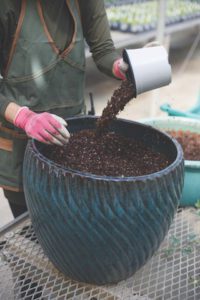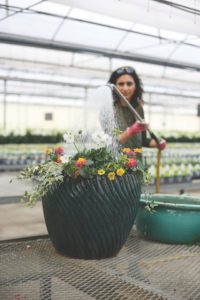Add color and texture to your landscape — without the work of maintaining flower beds (think, no weeds!).
Choose your pot
Whether you want concrete or glazed pottery, choosing the right pot is all about style. Looking for something classic? Concrete
might be more your style. If you are looking for color or something bolder, glazed pots can give you just that. Beyond aesthetics, the main difference is price and durability. Glazed pots do cost more, however they are far more durable than a concrete pot which is prone to cracking in very cold temps.
Select plants
There are four things to keep in mind when selecting your plants: color, light, styling and watering needs.

COLOR: What colors do you love/hate? What colors will look good with the pot you have selected? Ask yourself these questions before you start looking.
LIGHT: This is probably the most important factor to consider, because there are plants that need bright sunshine and those that will only tolerate shade. So you must know your plants! Some great sun options are wave petunias, periwinkles, superbells and lantana. Lantana is a great example of a heat tolerant plant that needs bright sunshine to thrive. Without it, you will not get many blooms. Some great shade options are caladiums, impatiens, begonias and torenia.
STYLING: When styling your pot, your plants should fall into three basic categories; thriller, filler and spiller. The thriller will be something tall that is either in the middle or to the back of the pot. These could be grasses such as a purple fountain or king tut grass, geraniums (for smaller pots), or an evergreen like a blue point juniper or a shaped boxwood. A spiller is any plant that will “spill” over the edge of the pots as it grows. Some of my favorites are petunias, superbells, ivy and creeping jenny. And lastly, you will need your filler. These are plants that fill in the spaces that are left such as periwinkles, euphorbia, chartreuse or an herb.
WATERING NEEDS: Every plant has specific watering needs, and this must be considered when selecting plants. Some are more drought and heat tolerant, like portulaca and lantana. Others need watering everyday, for example, a wave petunia. So these would not pair well in the same container. Overwatering leads to root rot which is pretty much a death sentence for a plant.
Arrange your plants
Follow these simple steps when planting your containers.
• Arrange plants while they are still potted so they may be easily moved around to see what looks best.
• Fill pot about 3⁄4 of the way with soil and start arranging with thriller first, then spiller and finally fill in with the filler.
• Check for spaces that need some extra soil and fill in as needed. Be sure you keep the soil level 1 to 2 inches from the rim of the pot.
Potting and soil tips
 FILLING THE POT: It is widely debated on whether or not you need rocks or other fillers for drainage in the pot. Unless I have a really large pot, I only use soil. On my larger pots I sometimes use mulch instead of gravel because it is lighter and so I am not wasting soil. Most important to proper drainage is to be sure your pot has a good size drainage hole, at least 1⁄2 inch to an inch. Not having a draining hole is a sure way to set up the container for failure.
FILLING THE POT: It is widely debated on whether or not you need rocks or other fillers for drainage in the pot. Unless I have a really large pot, I only use soil. On my larger pots I sometimes use mulch instead of gravel because it is lighter and so I am not wasting soil. Most important to proper drainage is to be sure your pot has a good size drainage hole, at least 1⁄2 inch to an inch. Not having a draining hole is a sure way to set up the container for failure.
SOIL: This is the foundation of your plants and what will help them thrive. We mix our own soil onsite with heat activated, slow release fertilizer. We recommend this because it automatically helps feed your plants throughout the heat of the summer.
Water and Display
Once you’ve finished potting your plants, give them a good drench so they can settle in the pot. This also allows the soil to settle so that you can see if any spots still need to be filled with extra soil. My favorite watering tip came from Mr. Fountain—treat your plants like you treat your kids—put them to bed dry! Watering in the morning is best for your plants.
A few random notes:
- Have fun with your pots, mixing in herbs or mosquito fighting plants like citronella or lavender (they smell so good!).
- Limit to three to five varieties of plants per container. Anymore and your pots might look confused!
- Don’t be afraid to try something new. Even the most seasoned gardeners kill plants. Sometimes it takes a little trial and error to see what works best in your yard.
- Seek out your local garden center or nursery—theyhave knowledgeable staffs that want to help you create something beautiful and they can give you all the tips and tricks you need to succeed.
SaveSave



